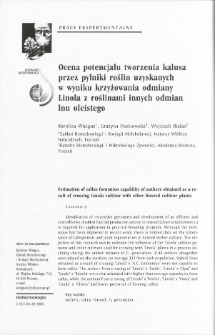
Object
Title: Ocena potencjału tworzenia kalusa przez pylniki roślin uzyskanych w wyniku krzyżowania odmiany Linola z roślinami innych odmian lnu oleistego
Creator:
Wielgus, Karolina ; Mańkowska, Grażyna ; Białas, Wojciech
Date issued/created:
Resource type:
Subtitle:
Publisher:
Komitet Biotechnologii PAN ; Instytut Chemii Bioorganicznej PAN
Abstract:
Identification of responsive genotypes and development of an efficient and cost-effective doubled haploid production system in linseed (Linum usitatissimum L.) is required for application in practical breeding program. Although the technique has been improved in recent years, there is limited data on the inheritance of callogenesis and plant regeneration in linseed anther culture. The objective of this research was to estimate the influence of the ‘Linola’ cultivar genome and other cultivars used for crossing with ‘Linola’ plants in a process declining during the anther cultures in Fj generation. 3144 anthers altogether were placed on the medium, on average 393 from each population. Hybrid lines obtained as a result of crossing ‘Linola’ x ‘A.C. Emmerson’ were not capable to form callus. The anthers from crossing of‘Linola’ x ‘Szafir’, ‘Linola’ x ‘Opal’ and ‘Linola’ x ‘Bionda’ were characterized with higher than average capacity to form callus, while the anthers from crossing of‘Linola’ x ‘Norlin’, ‘Linola’ x ‘Vinny’ and ‘Linola’ x ‘Oliwin’ had lower potential of forming callus.
Relation:
Biotechnologia, vol.81, 2 (2008)-.
Volume:
Issue:
Start page:
End page:
Detailed Resource Type:
Format:
Resource Identifier:
0860-7796 ; oai:rcin.org.pl:73897 ; IChB B-76
Source:
Biblioteka Instytutu Chemii Bioorganicznej PAN
Language:
Language of abstract:
Temporal coverage:
Rights:
Licencja Creative Commons Uznanie autorstwa-Na tych samych warunkach 4.0
Terms of use:
Digitizing institution:
Instytut Chemii Bioorganiczneji Polskiej Akademii Nauk
Original in:
Instytut Chemii Bioorganiczneji Polskiej Akademii Nauk
Projects co-financed by:
Access:
Object collections:
Last modified:
Oct 2, 2020
In our library since:
Jun 26, 2019
Number of object content downloads / hits:
161
All available object's versions:
https://rcin.org.pl/ichb/publication/96709
Show description in RDF format:
Show description in RDFa format:
Show description in OAI-PMH format:
Objects Similar
Tyczewska, Agata Bąkowska- Żywicka, Kamila
Pieczyński, Marcin Bielewicz, Dawid Dolata, Jakub Szweykowska-Kulińska, Zofia

 INSTYTUT ARCHEOLOGII I ETNOLOGII POLSKIEJ AKADEMII NAUK
INSTYTUT ARCHEOLOGII I ETNOLOGII POLSKIEJ AKADEMII NAUK
 INSTYTUT BADAŃ LITERACKICH POLSKIEJ AKADEMII NAUK
INSTYTUT BADAŃ LITERACKICH POLSKIEJ AKADEMII NAUK
 INSTYTUT BADAWCZY LEŚNICTWA
INSTYTUT BADAWCZY LEŚNICTWA
 INSTYTUT BIOLOGII DOŚWIADCZALNEJ IM. MARCELEGO NENCKIEGO POLSKIEJ AKADEMII NAUK
INSTYTUT BIOLOGII DOŚWIADCZALNEJ IM. MARCELEGO NENCKIEGO POLSKIEJ AKADEMII NAUK
 INSTYTUT BIOLOGII SSAKÓW POLSKIEJ AKADEMII NAUK
INSTYTUT BIOLOGII SSAKÓW POLSKIEJ AKADEMII NAUK
 INSTYTUT CHEMII FIZYCZNEJ PAN
INSTYTUT CHEMII FIZYCZNEJ PAN
 INSTYTUT CHEMII ORGANICZNEJ PAN
INSTYTUT CHEMII ORGANICZNEJ PAN
 INSTYTUT FILOZOFII I SOCJOLOGII PAN
INSTYTUT FILOZOFII I SOCJOLOGII PAN
 INSTYTUT GEOGRAFII I PRZESTRZENNEGO ZAGOSPODAROWANIA PAN
INSTYTUT GEOGRAFII I PRZESTRZENNEGO ZAGOSPODAROWANIA PAN
 INSTYTUT HISTORII im. TADEUSZA MANTEUFFLA POLSKIEJ AKADEMII NAUK
INSTYTUT HISTORII im. TADEUSZA MANTEUFFLA POLSKIEJ AKADEMII NAUK
 INSTYTUT JĘZYKA POLSKIEGO POLSKIEJ AKADEMII NAUK
INSTYTUT JĘZYKA POLSKIEGO POLSKIEJ AKADEMII NAUK
 INSTYTUT MATEMATYCZNY PAN
INSTYTUT MATEMATYCZNY PAN
 INSTYTUT MEDYCYNY DOŚWIADCZALNEJ I KLINICZNEJ IM.MIROSŁAWA MOSSAKOWSKIEGO POLSKIEJ AKADEMII NAUK
INSTYTUT MEDYCYNY DOŚWIADCZALNEJ I KLINICZNEJ IM.MIROSŁAWA MOSSAKOWSKIEGO POLSKIEJ AKADEMII NAUK
 INSTYTUT PODSTAWOWYCH PROBLEMÓW TECHNIKI PAN
INSTYTUT PODSTAWOWYCH PROBLEMÓW TECHNIKI PAN
 INSTYTUT SLAWISTYKI PAN
INSTYTUT SLAWISTYKI PAN
 SIEĆ BADAWCZA ŁUKASIEWICZ - INSTYTUT TECHNOLOGII MATERIAŁÓW ELEKTRONICZNYCH
SIEĆ BADAWCZA ŁUKASIEWICZ - INSTYTUT TECHNOLOGII MATERIAŁÓW ELEKTRONICZNYCH
 MUZEUM I INSTYTUT ZOOLOGII POLSKIEJ AKADEMII NAUK
MUZEUM I INSTYTUT ZOOLOGII POLSKIEJ AKADEMII NAUK
 INSTYTUT BADAŃ SYSTEMOWYCH PAN
INSTYTUT BADAŃ SYSTEMOWYCH PAN
 INSTYTUT BOTANIKI IM. WŁADYSŁAWA SZAFERA POLSKIEJ AKADEMII NAUK
INSTYTUT BOTANIKI IM. WŁADYSŁAWA SZAFERA POLSKIEJ AKADEMII NAUK
































